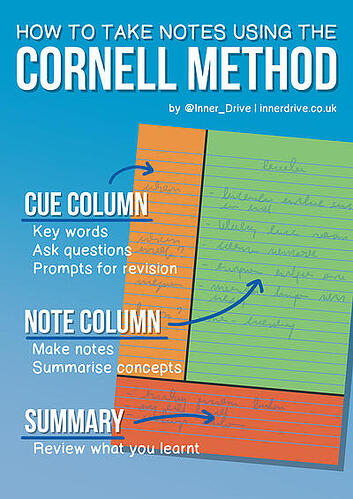While I’m for better ways to improve the learnability of information through different note-taking practices, implementing the cornel notes model as it was conceived here would be a huge undertaking. RemNote would have to explore the idea of new note types, designing a new, non-standard kind of note, then tackle issues as local as reference display to universal like export standards. It would not be feasible.
I instead suggest adapting the concept of cornel notes to RemNote. Cornel notes, as pictured above, consisted of three sections. When invented in the late 20th century, the cue column was seperated from the note-taking column by way of necessity. If the keywords and questions were interlaced with the main note-taking section, you would struggle with your hand to hide the information you wanted to test prior to recalling. In fact, each time you’d open your notes you’d see the information corresponding to the cues, thereby significantly diminishing the value of cues. The cue column was a paper-based workaround to address this problem
With RemNote, we no longer have this problem of accidentally answering our cues without effortful recall. We can fold nodes to hide information from view, and then unfold them after answering their cues. This leaves the most difficult aspect of adaption–the column–of marginal utility (although still achievable through @hannesfrank’s Custom Layout CSS).
For example, you could upgrade the summary section with cues through proper tilting of parent Rems. Or you could create a list of cues, alongside your main notes, and add portals as child rems. Or why not make use of in-line flashcards to write flashcards instead of cues, perhaps in their own section if you’d prefer a closer match to the original style.
What I think you’re asking, fundamentally, is a way to invoke a template for cornel notes. With RemNote templates, you can create a structure (I’ve pitched a few ideas) for these notes once and they’re available instantly via ##. That linked video walks through creating templates. In general, I differentiate between knowledge templates and note templates, where note templates format your whole Rem (or a section) and knowledge templates are semantically meaningful (e.g. Birth:, Death:, Notable achievements:).
What I’m describing here is a paradigm shift. When I look at traditional note-taking methods, like cornel notes, the question I ask is not “can RemNote add this?” but “how can I add this to RemNote?”, adapting the thought original thought process to our feature set. That is not to undercut your idea at all; it’s a great idea. I’d rather say we can implement the idea already with a tad of RemNote-infused creativity. And with templates, if you choose to check them out, I think you’ll have great fun in experimenting with different cornel note styles.
 .
.

